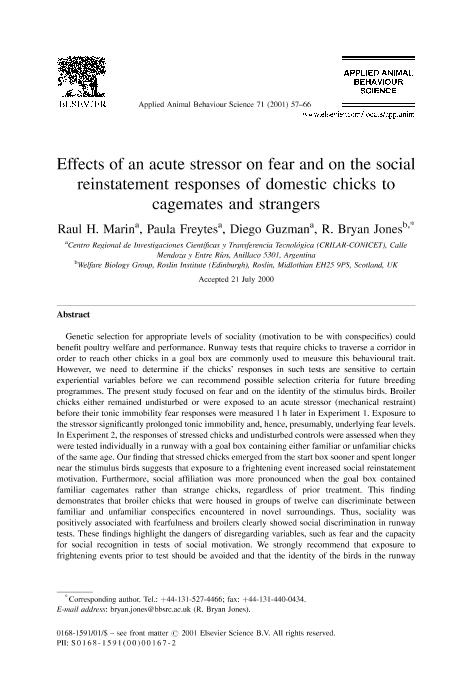Mostrar el registro sencillo del ítem
dc.contributor.author
Marin, Raul Hector

dc.contributor.author
Freytes, Paula

dc.contributor.author
Guzmán, Diego Alberto

dc.contributor.author
Bryan Jones, R.
dc.date.available
2018-12-07T15:19:14Z
dc.date.issued
2001-02-16
dc.identifier.citation
Marin, Raul Hector; Freytes, Paula; Guzmán, Diego Alberto; Bryan Jones, R.; Effects of an acute stressor on fear and on the social reinstatement responses of domestic chicks to cagemates and strangers; Elsevier Science; Applied Animal Behaviour Science; 71; 1; 16-2-2001; 57-66
dc.identifier.issn
0168-1591
dc.identifier.uri
http://hdl.handle.net/11336/66048
dc.description.abstract
Genetic selection for appropriate levels of sociality (motivation to be with conspecifics) could benefit poultry welfare and performance. Runway tests that require chicks to traverse a corridor in order to reach other chicks in a goal box are commonly used to measure this behavioural trait. However, we need to determine if the chicks' responses in such tests are sensitive to certain experiential variables before we can recommend possible selection criteria for future breeding programmes. The present study focused on fear and on the identity of the stimulus birds. Broiler chicks either remained undisturbed or were exposed to an acute stressor (mechanical restraint) before their tonic immobility fear responses were measured 1 h later in Experiment 1. Exposure to the stressor significantly prolonged tonic immobility and, hence, presumably, underlying fear levels. In Experiment 2, the responses of stressed chicks and undisturbed controls were assessed when they were tested individually in a runway with a goal box containing either familiar or unfamiliar chicks of the same age. Our finding that stressed chicks emerged from the start box sooner and spent longer near the stimulus birds suggests that exposure to a frightening event increased social reinstatement motivation. Furthermore, social affiliation was more pronounced when the goal box contained familiar cagemates rather than strange chicks, regardless of prior treatment. This finding demonstrates that broiler chicks that were housed in groups of twelve can discriminate between familiar and unfamiliar conspecifics encountered in novel surroundings. Thus, sociality was positively associated with fearfulness and broilers clearly showed social discrimination in runway tests. These findings highlight the dangers of disregarding variables, such as fear and the capacity for social recognition in tests of social motivation. We strongly recommend that exposure to frightening events prior to test should be avoided and that the identity of the birds in the runway goal box should be standardized, i.e. either familiar or unfamiliar, and noted. © 2001 Elsevier Science B.V.
dc.format
application/pdf
dc.language.iso
eng
dc.publisher
Elsevier Science

dc.rights
info:eu-repo/semantics/openAccess
dc.rights.uri
https://creativecommons.org/licenses/by-nc-sa/2.5/ar/
dc.subject
Chicken
dc.subject
Fear
dc.subject
Social Discrimination
dc.subject
Sociality
dc.subject
Stress
dc.subject
Tonic Immobility
dc.subject.classification
Biología

dc.subject.classification
Ciencias Biológicas

dc.subject.classification
CIENCIAS NATURALES Y EXACTAS

dc.title
Effects of an acute stressor on fear and on the social reinstatement responses of domestic chicks to cagemates and strangers
dc.type
info:eu-repo/semantics/article
dc.type
info:ar-repo/semantics/artículo
dc.type
info:eu-repo/semantics/publishedVersion
dc.date.updated
2018-11-12T13:46:47Z
dc.journal.volume
71
dc.journal.number
1
dc.journal.pagination
57-66
dc.journal.pais
Países Bajos

dc.journal.ciudad
Amsterdam
dc.description.fil
Fil: Marin, Raul Hector. Consejo Nacional de Investigaciones Científicas y Técnicas. Centro Regional de Investigaciones Científicas y Transferencia Tecnológica de La Rioja. - Universidad Nacional de La Rioja. Centro Regional de Investigaciones Científicas y Transferencia Tecnológica de La Rioja. - Universidad Nacional de Catamarca. Centro Regional de Investigaciones Científicas y Transferencia Tecnológica de La Rioja. - Secretaría de Industria y Minería. Servicio Geológico Minero Argentino. Centro Regional de Investigaciones Científicas y Transferencia Tecnológica de La Rioja. - Provincia de La Rioja. Centro Regional de Investigaciones Científicas y Transferencia Tecnológica de La Rioja; Argentina
dc.description.fil
Fil: Freytes, Paula. Consejo Nacional de Investigaciones Científicas y Técnicas. Centro Regional de Investigaciones Científicas y Transferencia Tecnológica de La Rioja. - Universidad Nacional de La Rioja. Centro Regional de Investigaciones Científicas y Transferencia Tecnológica de La Rioja. - Universidad Nacional de Catamarca. Centro Regional de Investigaciones Científicas y Transferencia Tecnológica de La Rioja. - Secretaría de Industria y Minería. Servicio Geológico Minero Argentino. Centro Regional de Investigaciones Científicas y Transferencia Tecnológica de La Rioja. - Provincia de La Rioja. Centro Regional de Investigaciones Científicas y Transferencia Tecnológica de La Rioja; Argentina
dc.description.fil
Fil: Guzmán, Diego Alberto. Consejo Nacional de Investigaciones Científicas y Técnicas. Centro Regional de Investigaciones Científicas y Transferencia Tecnológica de La Rioja. - Universidad Nacional de La Rioja. Centro Regional de Investigaciones Científicas y Transferencia Tecnológica de La Rioja. - Universidad Nacional de Catamarca. Centro Regional de Investigaciones Científicas y Transferencia Tecnológica de La Rioja. - Secretaría de Industria y Minería. Servicio Geológico Minero Argentino. Centro Regional de Investigaciones Científicas y Transferencia Tecnológica de La Rioja. - Provincia de La Rioja. Centro Regional de Investigaciones Científicas y Transferencia Tecnológica de La Rioja; Argentina
dc.description.fil
Fil: Bryan Jones, R.. Welfare Biology Group; Reino Unido
dc.journal.title
Applied Animal Behaviour Science

dc.relation.alternativeid
info:eu-repo/semantics/altIdentifier/url/https://www.sciencedirect.com/science/article/pii/S0168159100001672
dc.relation.alternativeid
info:eu-repo/semantics/altIdentifier/doi/https://dx.doi.org/10.1016/S0168-1591(00)00167-2
Archivos asociados
